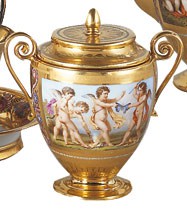The decorative arts
An up-to-date bibliography, an index and a number of essays accompany annotated photos and images of the works that were on display in an exhibition held first at the St. Louis Art Museum, then the Museum of Fine Arts in Boston before finishing in Paris at the Musée des Arts décoratifs. These studies offer an almost philosophical approach to the possible significance of each imperial symbol, choosing to focus on analysing the motifs present in the exhibits rather than their context or their style. Although the reader may find the catalogue lacking in historical context, this analytical approach taken to the exhibits has the benefit of encouraging questions that are often avoided elsewhere: does a strong political power necessarily have to draw on a properly-established “vocabulary” of decorative features? How and by whom are these symbols chosen? Why are they repeated so systematically?
Symbols borrowed from antiquity…
The ideas conveyed in the items on display were vital in eclipsing those of the revolutionary period, previously so omnipresent, in order to establish a new set of values. Taking a fresh look at the ancient model, Napoleon's architects, Percier (1764-1838) and Fontaine (1762-1853), brought about this revival. In 1801 they published a compendium on interior decoration, including everything related to furnishing, accompanied by engraved plates which would serve as inspiration for many of the decors of the early-19th century. The catalogue also evaluates the ornamental compendiums that many craftsmen drew on in their work, and puts an emphasis on the Empire Style's roots in antiquity.
…combining strength and sensitivity
In order to explain the subsequent development of the decorative arts, Napoleon's personal taste must be taken into account. Alongside this, the symbols of power also need to be defined. Napoleon's coronation on 2 December 1804 appears to have been a key moment in the permanent adoption of such symbols as the eagle and the bee. These are joined by allegorical war-figures such as la Victoire and la Renommée, the image of winged lightning and the Fritillaria floral motif. Although it is clear that Napoleon was heavily involved in the choice of motifs, he did however allow his subordinates, such as Denon (1747-1825) and Brongniart (1739-1813), a certain degree of freedom, a freedom which would leave their particular imprint on the items of the period.
Parallel to these images of power flourished other more gentle and sensual motifs, which took inspiration from the myths concerning love and the gods of antiquity. The story of Leda, loved by Zeus who took the form of a swan in seducing her, forms the basis for the representation of this bird that flourished under the empire. Another allegorical figure of desire, the butterfly, is also very present. These ideographical differences are evident in the well-conserved decor of the Hôtel de Beauharnais which was bought by Eugène in 1803: the two themes, warrior (emphasising Eugène's military qualities and his membership of the imperial family), and sensual (evoking the prince's musical disposition), exist side-by-side.
An international collaboration
The catalogue reveals not only Napoleon's personal taste regarding decorative arts but also that of the imperial family and indeed of First Empire society as a whole. The book is put together with the help of the American Federation of Arts, a governmental institution charged with the initiation and organisation of exhibitions. Members of the Museum of Fine Arts (Boston), Wadsworth Atheneum Museum of Art (Hartford, Connecticut) and the Centre allemand d'histoire de l'art (Paris) were equally involved. French participation included curators from museums both national and municipal, as well as the Musée des Arts décoratifs, the Fondation Napoléon and independent researchers.
The fruit of a very effective Franco-Germano-American collaboration, this book is without doubt a success.
Elodie Lerner (tr. and ed. H.D.W)
Place and year of publication: New York, 2007
Publishers: American Federation of Arts and Les Arts Décoratifs
Number of pages: 351


